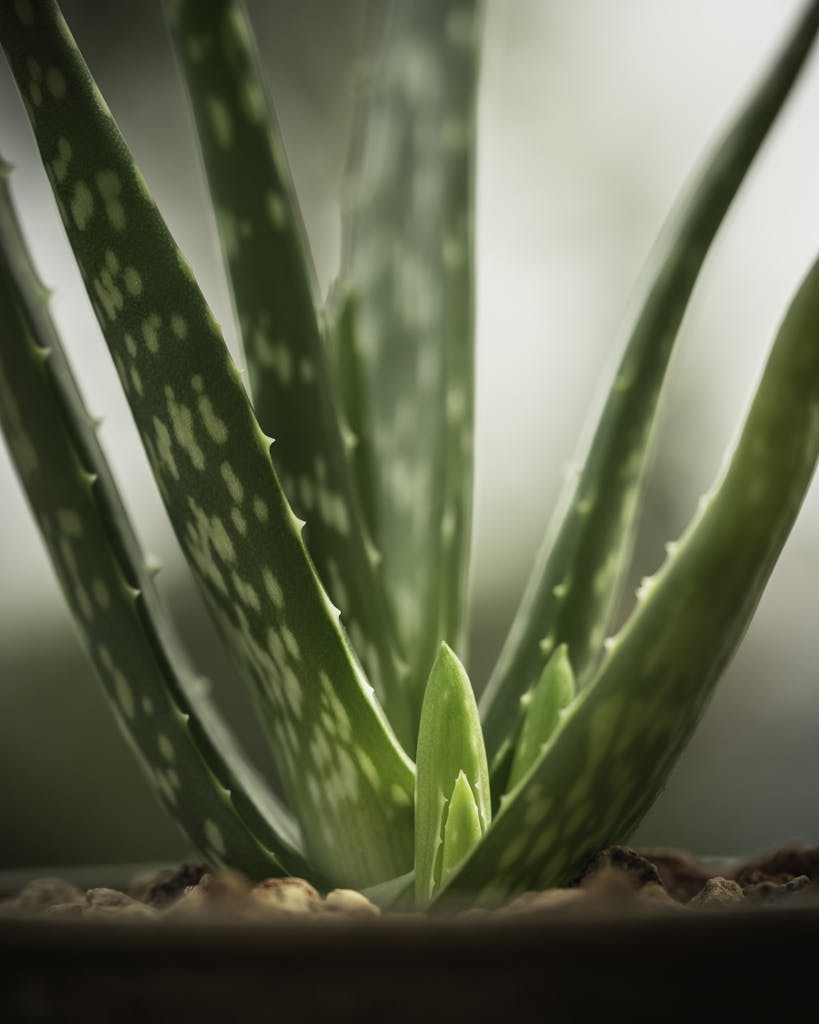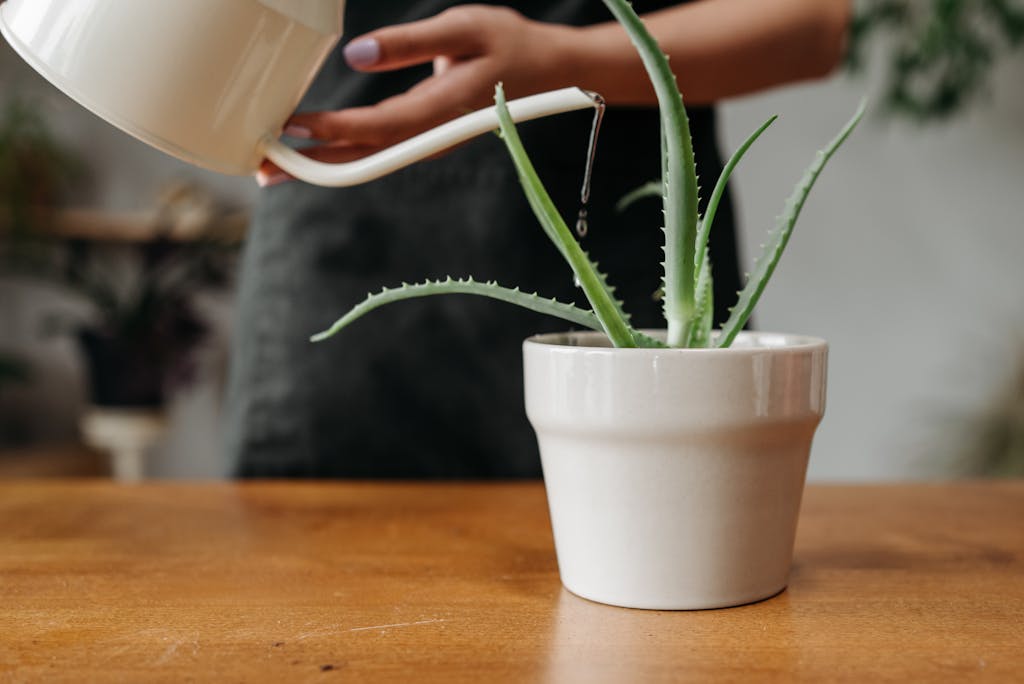Aloe Vera Plant Care and Growing Guide
Caring for an aloe vera plant doesn’t have to be a daunting task. Whether you’re a seasoned green thumb or a newbie to plant parenthood, you’ll find that with the right know-how, these resilient succulents can thrive in your home or garden. From mastering the ideal soil conditions to unlocking the secrets of proper watering, there’s more to growing a healthy aloe than meets the eye. But once you’ve got the basics down, you’ll be well on your way to enjoying the benefits of this versatile plant – from its soothing gel to its striking visual appeal. Ready to dive in?
Contents
Understanding Aloe Vera’s Needs

Successful aloe vera cultivation hinges on understanding its unique needs. Aloe vera thrives in well-draining soil and requires infrequent watering, as it’s prone to root rot in moist conditions.
Provide bright, direct sunlight, as aloe craves ample light. During the growing season, water when the soil’s top inch is dry, but cut back in winter when growth slows. Fertilize sparingly, 1-2 times per year, using a balanced, diluted formula.
Aloe vera has shallow roots, so choose a pot with drainage holes and avoid over-potting. Monitor for pests like mealybugs and scale insects, and address issues promptly. With the right care, this hardy succulent will reward you with its distinct, fleshy leaves and occasional flowers.
Planting and Potting Aloe Vera
When planting aloe vera, select a container with ample drainage holes to prevent soggy soil. Use a well-draining, cactus or succulent potting mix to ensure the plant’s roots don’t become waterlogged.
Plant the aloe in the center of the pot, leaving about an inch of space between the plant and the container’s edge. Water the aloe thoroughly after planting, then allow the soil to dry out before watering again.
Aloe vera thrives in bright, direct sunlight, so choose a spot that receives at least 6 hours of sun per day. When repotting, select a container only slightly larger than the previous one to avoid overpotting, which can lead to root rot.
Watering and Sunlight Requirements
Properly watering your aloe vera is crucial to its health and longevity. These succulents thrive on infrequent watering and well-drained soil. Water your aloe only when the soil is completely dry, typically every 2-3 weeks. Overwatering can lead to root rot, so be careful not to give it too much.

Aloe also requires plenty of bright, direct sunlight, preferably 6-8 hours per day. Place it in a south-facing window or outdoors in a sunny spot. If the leaves start to turn yellow or become soft, it’s a sign your aloe isn’t getting enough light. Adjust its location accordingly to ensure optimal growth and vibrant coloration.
Pruning and Propagating Aloe Vera
Pruning your aloe vera helps maintain its shape and encourages new growth. Use sharp, clean pruners to remove any damaged, discolored, or overcrowded leaves. Cut the leaves close to the base, taking care not to damage the main plant.
Propagating aloe vera is easy – simply remove a healthy, plump leaf and allow it to dry for a few days. Plant the leaf in well-draining soil and water sparingly until new growth appears. You can also divide the plant at the roots, ensuring each division has sufficient roots and leaves. Repot the divisions and keep them in bright, indirect light.
With proper pruning and propagation, you can enjoy your aloe vera for years to come.
Common Aloe Vera Issues and Solutions
Aloe vera plants can occasionally encounter common issues that may require attention. Yellowing leaves may indicate overwatering or underwatering, so adjust your watering schedule accordingly.
Brown spots could mean sun scorch, so move your plant to a less sunny location. Pests like mealybugs or spider mites can threaten the plant’s health, so inspect regularly and treat with insecticidal soap if needed.
Stunted growth may point to poor soil or incorrect pot size, so transplant into a larger container with well-draining cactus mix. Whatever the problem, act quickly to restore your aloe vera’s vitality. With the right care, it’ll thrive for years to come.
Frequently Asked Questions
Can I Use Aloe Vera to Treat Sunburn?
Yes, you can use aloe vera to treat sunburn. The cooling, soothing properties of aloe vera gel can help reduce inflammation and pain from sunburned skin. Apply the fresh, cool gel directly to the affected areas for relief.
How Long Does It Take for Aloe Vera to Grow?
Aloe vera plants can take 3 to 4 years to fully mature and reach their maximum size.
However, you can start using the leaves to treat sunburns once the plant is about 6 months old.
Can I Grow Aloe Vera Indoors Year-Round?
Yes, you can grow aloe vera indoors year-round. Aloe vera is a succulent that thrives in bright, sunny conditions and well-draining soil.
With the right environment, you can easily maintain an aloe plant indoors all year long.
How Often Should I Repot My Aloe Vera Plant?
You should repot your aloe vera plant every 2-3 years or when it becomes rootbound. This will provide it with fresh soil and enough room to continue growing.
Be sure to use a well-draining potting mix when repotting.
Are There Any Health Benefits of Consuming Aloe Vera?
Aloe vera contains beneficial compounds that may help soothe burns, reduce inflammation, and improve digestive health when consumed. However, it’s important to consult your doctor before ingesting aloe vera, as it can interact with certain medications.
Aloe vera contains beneficial compounds that may help soothe burns, reduce inflammation, and improve digestive health when consumed. However, it’s important to consult your doctor before ingesting aloe vera, as it can interact with certain medications.
Conclusion
With proper care, you can enjoy the benefits of an aloe vera plant for years to come. Remember to provide well-draining soil, bright sunlight, and infrequent watering. Fertilize sparingly, prune when needed, and propagate new plants from healthy leaves. By following these guidelines, you’ll have a thriving aloe vera that can soothe your skin and add a touch of greenery to your home.
